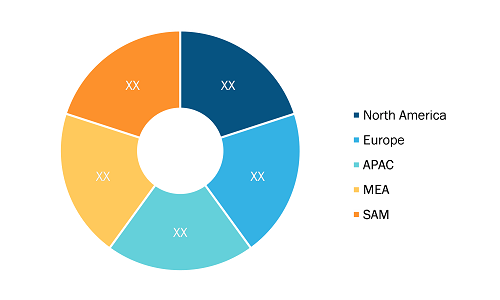The commercial air traffic management market was valued at US$ 5,644.85 million in 2022; registering at a CAGR of 7.8% from 2022 to 2030, according to a new research study conducted by The Insight Partners.
The increasing number of aircraft deliveries is raising the demand for various types of aircraft operations, ultimately generating new opportunities for commercial air traffic management market players across different regions. The rising need for aircraft communication, navigation, pilot interfaces, flight plan negotiation, and other types of flight operations catalyze the commercial aircraft air traffic management operations. Thus, the growing volume of aircraft deliveries worldwide is likely to augment the global commercial air traffic management market growth.
Commercial Air Traffic Management Market Share – by Region, 2021
Commercial Air Traffic Management Market Size and Forecast (2021 - 2031), Global and Regional Share, Trend, and Growth Opportunity Analysis Report Coverage: By Type (Air Traffic Services, Air Traffic Flow Management, and Airspace Management), Component [Hardware (Radars, Antennas, Display Systems, And Others) and Software], Application [Communication, Navigation (CVOR, DVOR, DME, ILS, DF, and NDB), Surveillance (PSR, SSR, and MLAT), Traffic Control, and Others], Airport Class (Class I, Class II, Class III, and Class IV), and Geography
Commercial Air Traffic Management Market Outlook by 2031
Download Free Sample
Source: The Insight Partners Analysis
The introduction of next-generation fuel-efficient commercial aircraft models and low-cost airlines is driving aircraft movement volumes in airports worldwide. This is urging the civil aviation authorities across developed and developing countries to develop new airports for supporting the rising aircraft fleet. The rising construction of new airports across different countries is also fueling the demand for commercial air traffic management. In February 2021, China’s Airports Council International (ACI) announced the construction of 150 new civilian airports by the end of 2035, wherein ~10 new airports are expected to be constructed every year. In 2022, the Indian Directorate General of Civil Aviation (DGCA) announced that the Indian aviation industry could have ~80 new airports in the next five years. The country also witnessed the number of airports rising from 74 to 141 in the past eight years. Approximately 15–16 airports are constructed every year across India. These factors are increasing the fleet of aircraft models in the country and assisting the installation of air traffic management systems across the new airports. Such developments are expected to surge the global commercial air traffic management market growth.
The Canadian aviation industry handled air traffic of ~28.4 million passengers in 2020, compared to 94.1 million passengers in 2019. This was mainly due to the COVID-19 outbreak and the drastic reduction in air travel across the country. This also led to a decline in the demand for airport upgrades, expansion projects, and newer installation of different types of air traffic management systems across the country’s airports. Moreover, Canada’s ATC infrastructure operates privately and continues to serve Canadian carriers across the country for a very long time. Several commercial air traffic management market players have been collaborating with different airports across the country to provide them with reliable traffic management systems and remain competitive in the Canadian market.
Impact of COVID-19 Pandemic on Commercial Air Traffic Management Market
The US government imposed a nationwide lockdown in the Q2 of 2020 due to the continuous growth of COVID-19 cases. At that time, most manufacturing plants were temporarily shut or operating with minimum staff. The supply chain of components was also disrupted. Since the US has a larger density of aircraft manufacturers, component manufacturers, and airports, the outbreak has severely affected production and revenue generation. The presence of limited manufacturing staff hindered the production quantity. Also, the suspension of air travel resulted in a loss of airport revenue, which restricted the demand for airport-associated technologies. This factor stalled the revenue generation stream of the commercial air traffic management market. All the above factors restrained the market in North America. However, during the Q3 of 2020, the manufacturing industries started to open, and the supply chain resumed its operations. Also, the demand for advanced air traffic management systems raised at the airports due to the airport expansion or development plan. For instance, in September 2020, the Salt Lake City International Airport opened its US$ 4.1 billion facility with a new terminal and its first concourse.
The commercial air traffic management market is segmented based on type, component, application, airport class, and geography. Based on type, the commercial air traffic management market is segmented into air traffic services, air traffic flow management, and airspace management. In terms of component, the market is bifurcated into hardware and software. Based on application, the market is categorized into communication, navigation, surveillance, traffic control, and others. In terms of airport class, the market is segmented into class I, class II, class III, and class IV. By geography, the market is primarily segmented into North America, Europe, Asia Pacific (APAC), the Middle East & Africa (MEA), and South America.
Thales Group; Indra Systemas; L3 Harris Technologies, Inc.; Leonardo S.p.A; and Honeywell International Inc. are among the key players operating in the commercial air traffic management market. During this study, several major market players were analyzed to get a holistic view of the global commercial air traffic management market share and its ecosystem.
Contact Us
Phone: +1-646-491-9876
Email Id: sales@theinsightpartners.com